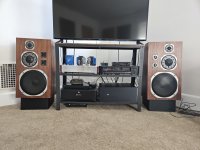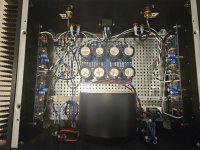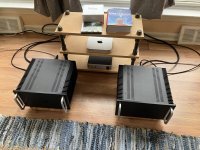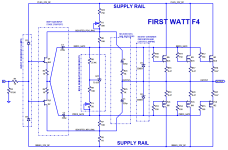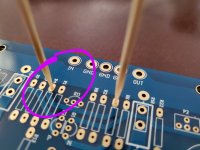I should clarify that when I said R19 be swapped, I meant the mosfets, not the resistors. My fault for any confusion.
My thought was that each triplet set sees the same Vg. If one triplet has a mosfet with higher current than the other two, and the other triplet has a mosfet with lower current than the other two, do a swap to try to even it out.
there is no logic to expect N triplet in one channel having same Ugs as N triplet in other channel
same for P triplets
except in case that triplets are actually matched sextet cut in half....... which can be but doesn't need to be the case
same for P triplets
except in case that triplets are actually matched sextet cut in half....... which can be but doesn't need to be the case
Yes I understand that. Again I wasn't clear. I meant to say each mosfet in a triplet sees the same Vg. I was about to edit my post but you were fast.
I think that it is worth a try as there is a discrepancy in both channels, and it only involves switching two mosfets. It may or may not make a big difference.
Or it can be left as-is as the difference is probably not audible. 🙂
I think that it is worth a try as there is a discrepancy in both channels, and it only involves switching two mosfets. It may or may not make a big difference.
Or it can be left as-is as the difference is probably not audible. 🙂
well, if we get measured Ugs value combined with reading across source resistors, clearly made table of values for each triplet ............ then we can guess better/easier
🙂
🙂
Well I decided to postpone fretting over fets right now and just listen to the amp. It might be the best amp I've ever heard. I would put in in the top three, which include my other two Firstwatt builds - the M2X and Aleph J. The Aleph J has a glorious midrange. The M2X, with the Mountain View daughter boards have excellent balanced sound top to bottom. Tight articulate bass. The F4 is like this, only with maybe a bit more transparency and more "air" around the instruments and singers.
Using it with a Benchmark DAC2 dac/preamp and Yamaha NS-1000M speakers. With the Benchmark cranked wide open, I'm getting around 78 - 80 db average at my listening position, in a 13 x 14 ft room. This is satisfactory for most of my listening, except maybe after I've had a couple drinks, which doesn't happen much anymore.
Already considering building another F4 and a beefier preamp to run F4 monoblocks.
Using it with a Benchmark DAC2 dac/preamp and Yamaha NS-1000M speakers. With the Benchmark cranked wide open, I'm getting around 78 - 80 db average at my listening position, in a 13 x 14 ft room. This is satisfactory for most of my listening, except maybe after I've had a couple drinks, which doesn't happen much anymore.
Already considering building another F4 and a beefier preamp to run F4 monoblocks.
Attachments
Curious, are you driving the F4 off the Benchmark balanced or single ended? My friend seemed to think the DAC2 ran out of voltage swing driving my F6, which is single ended, and it sounds like you had to crank it to 11. Been wondering if balanced drive off the Benchmark was substantially better.Well I decided to postpone fretting over fets right now and just listen to the amp. It might be the best amp I've ever heard. I would put in in the top three, which include my other two Firstwatt builds - the M2X and Aleph J. The Aleph J has a glorious midrange. The M2X, with the Mountain View daughter boards have excellent balanced sound top to bottom. Tight articulate bass. The F4 is like this, only with maybe a bit more transparency and more "air" around the instruments and singers.
Using it with a Benchmark DAC2 dac/preamp and Yamaha NS-1000M speakers. With the Benchmark cranked wide open, I'm getting around 78 - 80 db average at my listening position, in a 13 x 14 ft room. This is satisfactory for most of my listening, except maybe after I've had a couple drinks, which doesn't happen much anymore.
Already considering building another F4 and a beefier preamp to run F4 monoblocks.
Already considering building another F4 and a beefier preamp to run F4 monoblocks.
Maybe consider increasing the Benchmark DAC gain a notch, if you are brave... Inserting the interconnects, volume pot and another gain stage with its hookup wiring and whatnot inside the box, will always be inferior. With a good, noble source of ample output capability, all you need is a current boost. The no-frills approach. An F4 could've been my next amp if it wasn't for the single-ended input. So, I spent time getting Aleph J to the point of being good... but it takes time.
Curious, are you driving the F4 off the Benchmark balanced or single ended? My friend seemed to think the DAC2 ran out of voltage swing driving my F6, which is single ended, and it sounds like you had to crank it to 11. Been wondering if balanced drive off the Benchmark was substantially better.
Using these cables which I bought from Benchmark to go from the balanced out on the Benchmark to the SE input on the F4:
Benchmark XLRF to RCA Adapter Cable for Analog Audio - pin 3 floating
https://benchmarkmedia.com/products/benchmark-xlrfm-to-rca-adapter-cable-pin-3-floating
I didn't think twice about building a second F4. They can definitely take advantage of the extra voltage swing the Benchmark balanced outputs provide. Recommended to crack the case to check if the balanced output jumpers are set for 0dB attenuation.
Maybe consider increasing the Benchmark DAC gain a notch, if you are brave... Inserting the interconnects, volume pot and another gain stage with its hookup wiring and whatnot inside the box, will always be inferior. With a good, noble source of ample output capability, all you need is a current boost. The no-frills approach. An F4 could've been my next amp if it wasn't for the single-ended input. So, I spent time getting Aleph J to the point of being good... but it takes time.
Yes, the internal jumpers are set to 0bd attenuation.
6sX7 - did you add XLR connectors to your F4's? What interconnects are you using?
I know some people around here don't believe in burn in, but I've heard it with two identical board builds of the f4. It'll sound even better in a couple weeks, enjoy. Love my f4 monoblocks.Well I decided to postpone fretting over fets right now and just listen to the amp. It might be the best amp I've ever heard. I would put in in the top three, which include my other two Firstwatt builds - the M2X and Aleph J. The Aleph J has a glorious midrange. The M2X, with the Mountain View daughter boards have excellent balanced sound top to bottom. Tight articulate bass. The F4 is like this, only with maybe a bit more transparency and more "air" around the instruments and singers.
Using it with a Benchmark DAC2 dac/preamp and Yamaha NS-1000M speakers. With the Benchmark cranked wide open, I'm getting around 78 - 80 db average at my listening position, in a 13 x 14 ft room. This is satisfactory for most of my listening, except maybe after I've had a couple drinks, which doesn't happen much anymore.
Already considering building another F4 and a beefier preamp to run F4 monoblocks.
I just hooked up a BA3 front end to my F4 to fix my gain structure. It sounds wonderful (and thanks to ZM and Jim for the build guide and biasing procedure).
As such, I'm now looking at removing the input buffer from my F4s. Based on the schematics for the F4 and the Crippled version, it looks like I achieve this by simply bypassing the input buffer... which could be achieved by moving the input wire to the "top" of R4 (or R3) as highlighted in my photo of the store board.
Is that really all there is to the process, or would it be better to remove the input buffer components as well?

As such, I'm now looking at removing the input buffer from my F4s. Based on the schematics for the F4 and the Crippled version, it looks like I achieve this by simply bypassing the input buffer... which could be achieved by moving the input wire to the "top" of R4 (or R3) as highlighted in my photo of the store board.
Is that really all there is to the process, or would it be better to remove the input buffer components as well?
Attachments
Essentially yes, but I’d strongly suggest leaving it as-is. It’s an invisible buffer, it makes no impact on the sound at all, your BA3FE will work perfectly perfectly with it there (as will any other preamp you may want to try in the future), and keeping the buffer leaves your F4 able to be used in all of it’s various possibilities, which is something that should stay intact.
Just sit back and enjoy the music, while planning your next project…
😎
Just sit back and enjoy the music, while planning your next project…
😎
That's why I was hoping I could just move the input wire from the top of the board to the top of R4... only one quick change to put it back to stock. I've already got the BA3 and F4 together in one chassis... had a lot of extra room because I've got single channel monoblocks with external power supplies.Essentially yes, but I’d strongly suggest leaving it as-is. It’s an invisible buffer, it makes no impact on the sound at all, your BA3FE will work perfectly perfectly with it there (as will any other preamp you may want to try in the future), and keeping the buffer leaves your F4 able to be used in all of it’s various possibilities, which is something that should stay intact.
And thanks so much for the speedy reply! 🙏
Crippled is made for Poor Punters not having precioussssssss JFets
if you have them, use them
if you have them, use them
- Home
- Amplifiers
- Pass Labs
- A guide to building the Pass F4 amplifier
